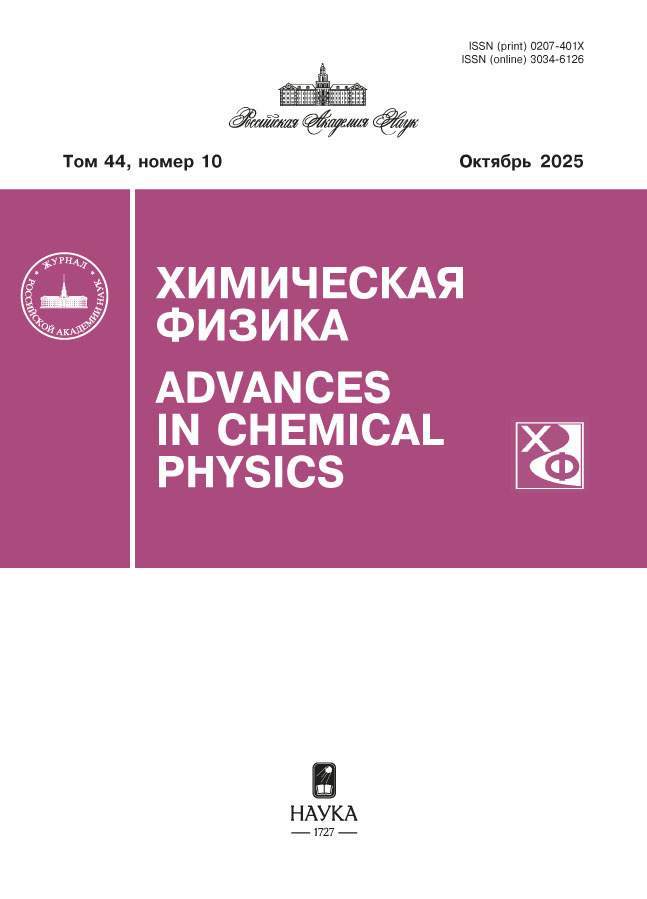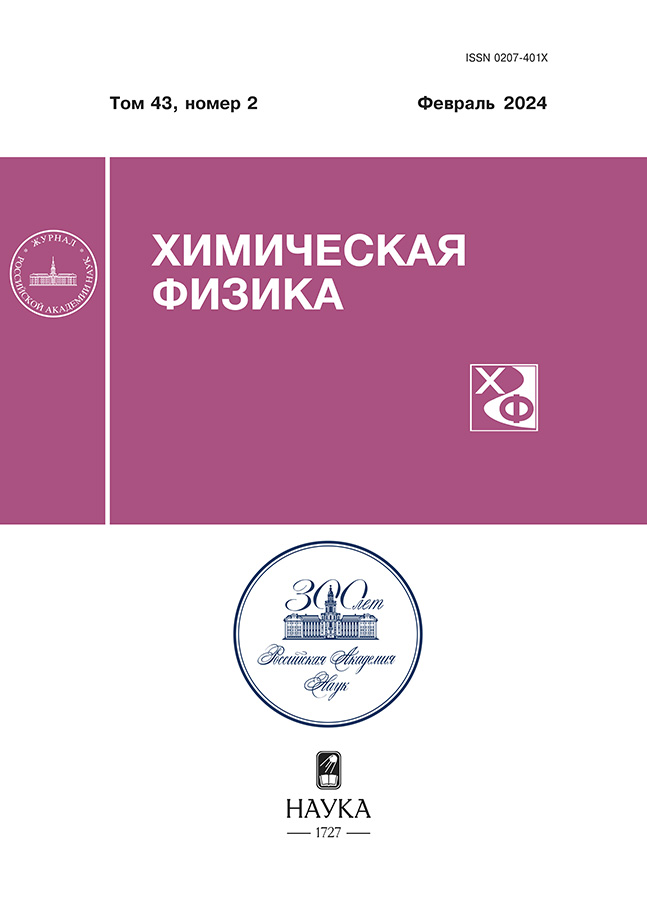Cationic effect in the formation of toxic and antiviral properties of Keggon heteropoly compounds
- Authors: Dalidchik F.I.1, Lopatina O.A.2, Kovalevsky S.A.1, Isaeva E.I.2, Bidevkina M.V.3, Baklanova O.V.2, Gushchina E.A.2, Lisitsyn F.V.2, Balashov E.M.1, Mezentseva M.V.4, Pritchina T.N.2
-
Affiliations:
- Semenov Federal Research Center for Chemical Physics, Russian Academy of Sciences
- Gamaleya Research Institute of Epidemiology and Microbiology
- Erisman Federal Scientific Center of Hygiene, Federal Service for Supervision of Consumer Rights Protection and Human Welfare
- Национальный исследовательский центр эпидемиологии и микробиологии им. Н.Ф. Гамалеи
- Issue: Vol 43, No 2 (2024)
- Pages: 92-102
- Section: Chemical physics of biological processes
- URL: https://cardiosomatics.orscience.ru/0207-401X/article/view/674990
- DOI: https://doi.org/10.31857/S0207401X24020108
- EDN: https://elibrary.ru/WHBSQN
- ID: 674990
Cite item
Abstract
The Cytotoxicity indices (IC50) of Keggin’s phosphorus-molybdenum heteropoly acids (HPCAs) and their sodium and potassium salts on dog kidney cells (MDSC) were determined. The antiviral activity of these compounds against topical strains of influenza A (H3N2 and H1N1) was revealed. The dependence of the biological properties of polyoxometalates (POMs) on the elemental composition of their molecules has been confirmed. It has been shown that when some of the molybdenum atoms are replaced by vanadium atoms, HPCA and their salts acquire higher cytotoxicities, which increase monotonically as the number of substitutions increases. For the first time, the dependence of the biological activity of HPCA and their salts on the mass of cations has been established and interpreted. In vivo (on white outbred mice) the values of semi-lethal doses (DL50) of these compounds were established. For aqueous solutions of sodium and potassium salts of GPCA in a wide range of concentrations (from 0.05 μM to 15 μM), the values of the toxicity index (It) were determined on the model of motile cells. It has been established that GPCA and their salts are classified as moderately dangerous toxic substances and have selective antiviral activity, which at low concentrations (less than 15 μM) for influenza A strains is manifested mainly by a decrease in hemagglutination activity (HA).
Full Text
About the authors
F. I. Dalidchik
Semenov Federal Research Center for Chemical Physics, Russian Academy of Sciences
Author for correspondence.
Email: domfdal@mail.ru
Russian Federation, Москва
O. A. Lopatina
Gamaleya Research Institute of Epidemiology and Microbiology
Email: domfdal@mail.ru
Russian Federation, Moscow
S. A. Kovalevsky
Semenov Federal Research Center for Chemical Physics, Russian Academy of Sciences
Email: domfdal@mail.ru
Russian Federation, Moscow
E. I. Isaeva
Gamaleya Research Institute of Epidemiology and Microbiology
Email: domfdal@mail.ru
Russian Federation, Moscow
M. V. Bidevkina
Erisman Federal Scientific Center of Hygiene, Federal Service for Supervision of Consumer Rights Protection and Human Welfare
Email: domfdal@mail.ru
Russian Federation, Mytishchi
O. V. Baklanova
Gamaleya Research Institute of Epidemiology and Microbiology
Email: domfdal@mail.ru
Russian Federation, Moscow
E. A. Gushchina
Gamaleya Research Institute of Epidemiology and Microbiology
Email: domfdal@mail.ru
Russian Federation, Moscow
F. V. Lisitsyn
Gamaleya Research Institute of Epidemiology and Microbiology
Email: domfdal@mail.ru
Russian Federation, Moscow
E. M. Balashov
Semenov Federal Research Center for Chemical Physics, Russian Academy of Sciences
Email: embalashov@yandex.ru
Russian Federation, Moscow
M. V. Mezentseva
Национальный исследовательский центр эпидемиологии и микробиологии им. Н.Ф. Гамалеи
Email: domfdal@mail.ru
Russian Federation, Moscow
T. N. Pritchina
Gamaleya Research Institute of Epidemiology and Microbiology
Email: domfdal@mail.ru
Russian Federation, Moscow
References
- Catalano A., Iacopetta D., Ceramella J. et al. // Molecules. 2022. V. 27. № 3. P. 616.
- Rhule J.T., Hill C.L., Judd D.A. // Chem. Rev. 1998. V. 98. P. 327l.
- Aureliano M. // BioChem. 2022. V. 2. № 1. P. 8.
- Aureliano M., Gumerova N. I., Sciortino G. et al. // Coord. Chem. Rev. 2022. V. 454. P. 214344.
- Bij elic A., Aureliano M., Rompel A. // Angew. Chem. Intern. Ed. Engl. 2019.V. 58. № 10. P. 2980.
- Soares S.S., Henao F., Aureliano M. et al. // Chem. Res. Toxicol. 2008. V. 21. № 3. P. 607.
- Soares S.S., Gutierrez-Merino C., Aureliano M. // J. Inorg. Biochem. 2007. V. 101. № 5. P. 789.
- Aureliano M., Ohlin C.A. // Ibid. 2014. V. 137. P. 123.
- Khabriev R.U. Guidelines for the experimental (preclinical) study of new pharmacological substances. M.: Medicine, 2005.
- State Standard of the Russian Federation No. 862-st dated December 29, 1999. Evaluation of the biological effect of medical devices. Part 5. Cytotoxicity testing: in vitro methods. Annex A) Mobile cells.
- AT-50 Image Analyzer User Manual. Appendix to the operating manual for BMKI 01.00.00.00 RE.M.ZAO BMK-INVEST, 2009. p.51.
- National standard of the Russian Federation 12.1.007-76 Occupational safety standards system (SSBT). Harmful substances. Classification and general safety requirements (with Amendments № 1, 2).
- Virology: A practical approach. Ed. B. Mahy. Publisher: Oxford University Press, 1985.
- Lopatina O.A., Suetina I.A., Mezentseva M.V. et al. // Russ. J. Phys. Chem. B. 2020. V. 14. № 1. P. 81.
- Yamase T., Fujita H., Fukushima K. // Inorg. Chim. Acta. 1988. V. 151. P. 15.
- Dianat S., Bordbar A.-K., Tangestaninejad S. et al. // J. Inorg. Biochem. 2015. V. 152. P. 74.
- Qi W., Zhang B., Qi Y. et al. // Molecules. 2017. V. 22. № 9. P. 1535.
- Autzen H.E., Myasnikov A.G., Campbell M.G. et al. // Science. 2018. V. 359. № 6372. P. 228.
- Bajimaya S., Frankl T., Hayashi T. et al. // Virology. 2017. V. 510. P. 234.
- Kovalevskiy S.A., Lopatina O.A., Gushchina E.A. et al. // Russ. J. Phys. Chem. B. 2021. V. 15. № 6. P. 1019.
- Dalidchik F.I., Balashov E.M., Baklanova O.V. et al. // Nanobiotechnology Reports. 2022. V. 17. № 2. P. 193.
- Lopatina O.A., Dalidchik F.I., Balashov E.M. et al. // Infectious diseases in the modern world: evolution, current and future threats: Proceedings of the XIV Annual All-Russian Congress on Infectious Diseases named after academician V.I. Pokrovsky // Moscow, March 28–30, 2022. M.: Medical Marketing Agency, 2022. P. 103.
- Chazal N., Gerlier D. // Microbiol. Mol Biol. Rev. 2003. V. 67. № 2. P. 226.
- Savintseva L.A., Avdoshin A.A., Ignatov S.K. // Russ. J. Phys. Chem. B. 2022. V. 16. № 3. P. 445.
- Shishkisha L.N., Kozlov M.V.,. Konstantinova T.V. et al. // Russ. J. Phys. Chem. B. 2023. V. 17. № 1. P. 141.
- Tereshkin E.V., Tereshkina K.B., Loiko N.G. et al. // Russ. J. Phys. Chem. B. 2023. V. 17. № 4. P. 564.
Supplementary files















